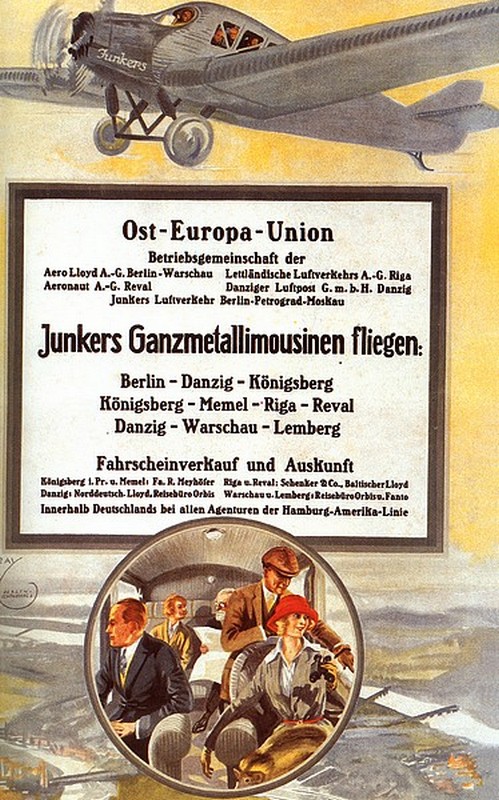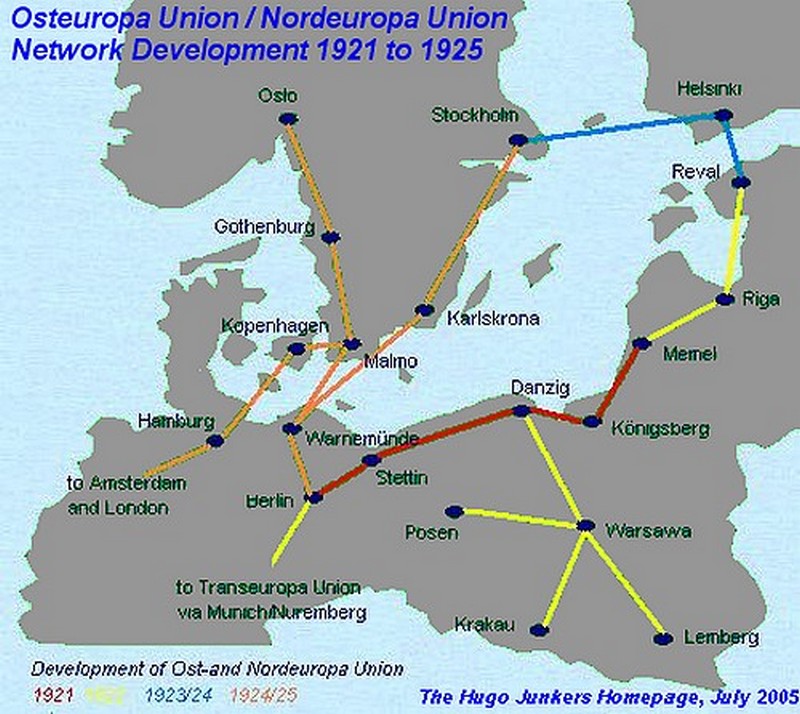Junkers Osteuropa Union / Nordeuropa Union

Founded:
June 1923 Osteuropa Union in Riga
December 1923 Nordeuropa Union
Shareholders:
Junkers Flugzeugwerke A.G.
Danziger Luftpost GmbH
Members:
Danziger Luftpost GmbH
Aerolloyd Warschau
Latvija Gaisa Satiksmes
Junkers Luftverkehr Russland
A-S Aeronaut
Aero O/Y (since Oct. 1923)
A.B. Aerotransport (since Mar. 1924)
Junkers Luftverkehrs A.G. (since Aug. 1924)
Management Positions:
Network:
Company Development:
In 1923 Junkers and Sachsenberg supported the foundation of several airlines in the Baltic area. These airlines were needed for a Baltic network, which started at Berlin and ended at Helsinki. Extensions to Russia were planned from Koenigsberg to Moscow by Junkers Luftverkehr Russia. With the foundation of Aeronaut in July 1923 the Baltic routes were established and handled by five airline organisations.
Each of these airlines was responsible for the marketing, the flight operation and the local airfield operation in its area or country. Some routes were operated jointly by two partners, i.e. the Riga to Reval routes by Lettlaendische Luftverkehrs A.G. and Aeronaut. Other routes were operated by one partner only. Also there was a lack of a common marketing organisation and marketing name for the common airline network.
To fill these organisational gaps, Osteuropa Union was founded in June 1923 at Riga in Latvia. OEU was the marketing and clearing organisation for the Baltic network operations. More or less the above foundation members operated under the name of OEU. Osteuropa Union on the other hand was responsible for the financial exchange between the partners, i.e. operational cost exchanges and distribution of ticket sales.
In autumn 1923 it became clear, that Junkers Luftverkehr Russland would not obtain the rights for the Koenigsberg to Moscow route and also the intended routing from Petersburg to Baku would not be continued in 1924. That meant, that Junkers would retreat from the Russian air transport market. Instead it was intended to extend the Baltic network towards Scandinavia in 1924. In preparation of this extension, Osteuropa Union was renamed into Nordeuropa Union in December 1923. Nevertheless, the name "Nordeuropa Union" was seldom used in public while "Osteuropa Union" was still used on posters and advertisments.
In March 1924 A.B. Aerotransport in Sweden joint the NEU consortium. The managing director of A.B. Aerotransport Carl Florman intensified the extension of the Nordeuropa Union throughout Scandinavia. He promoted the foundation of the Norwegian Norsk Aerotransport and the Danish Dansk Lufttransport in 1924, which should operate the routes between Oslo, Copenhagen and Stockholm within a Scandinavian Union. However, the Norsk Aerotransport was unable to start operations in 1925. Junkers was also looking for the Dansk Lufttransport as a Northern extension of the Transeuropa Union instead of a local extension in Scandinavia. Therefore the Scandinavian Union remained as an idea of Florman and was finally not achieved during the times of Junkers Luftverkehr.
Another idea of Florman was the establishment of a Northwest Passage from Scandinavia to the Netherlands and England. Therefore Florman contacted Nederlandsche Werekdverkeer Maatschappij. Both airlines started operations from Malmo via Copenhagen to Amsterdam and later extended this service with the help of Air Express Company in England to London. The developement of this routing was mostly independent from the Junkers developements. They were based on bilateral agreements between A.B. Aerotransport, NWM and Air Express. Nevertheless, the discussions with NWM finally led to a cooperation within the Transeuropa Union later on.

The Nordeuropa Union developed the Baltic and Scandinavian network independent from a second organisation in Central Europe. This organisation was called Transeuropa Union, which was responsible for the internal German air traffic and the air traffic in Southern Europe. In 1925 both organisations had developed the backbone of their networks, but both networks still worked independently from each other. On 7th May 1925 both organisations were merged within the Europa Union. Nordeuropa Union and Transeuropa Union networks were now linked at their common Berlin hub and timetables were modified for throughgoing connections. The former Osteuropa Union routes from Helsinki to Berlin and from Stockholm to Berlin were now continued within the former Transeuropa network from Helsinki and Stockholm to Geneve and Budapest with connecting flights along the German airports.
The further developement of this European network was continued by Europa Union during 1925.
introduced Aug 1996, transfered Dec 2017
http://hugojunkers.bplaced.net/
contents last updated 31 Jul 2005

